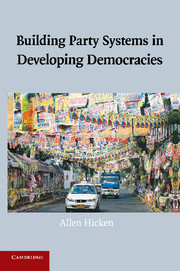Book contents
- Frontmatter
- Contents
- Acknowledgments
- Building Party Systems in Developing Democracies
- 1 Introduction
- 2 A Theory of Aggregation Incentives
- 3 Testing the Theory
- 4 Aggregation, Nationalization, and the Number of Parties in Thailand
- 5 Explaining Aggregation in Thailand
- 6 Term Limits, Aggregation Incentives, and the Number of Parties in the Philippines
- 7 Conclusion
- References
- Index
6 - Term Limits, Aggregation Incentives, and the Number of Parties in the Philippines
Published online by Cambridge University Press: 29 July 2009
- Frontmatter
- Contents
- Acknowledgments
- Building Party Systems in Developing Democracies
- 1 Introduction
- 2 A Theory of Aggregation Incentives
- 3 Testing the Theory
- 4 Aggregation, Nationalization, and the Number of Parties in Thailand
- 5 Explaining Aggregation in Thailand
- 6 Term Limits, Aggregation Incentives, and the Number of Parties in the Philippines
- 7 Conclusion
- References
- Index
Summary
INTRODUCTION
In many respects, the party systems of Thailand and the Philippines look very similar. In both countries, party labels have historically been weak, party switching is rampant, and party cohesion is low. Where Thailand and the Philippines diverge is in the number of parties at the national level. Recall that in Thailand the average effective number of parties nationally prior to constitutional reform was 7.2. The corresponding figure for the Philippines over the course of its democratic history is a more modest 2.6. However, as in Thailand, there is substantial variation over time in the number of parties. Specifically, in the democratic period before martial law the effective number of parties at the national level averaged 2.3. After the fall of Marcos, the number of parties increased to 3.6 on average. Why this large increase? The inflation of the party system post-Marcos has long been a puzzle for scholars of Philippine politics, and this chapter provides an answer to that puzzle that is superior to existing explanations. How, too, do we explain the differences in the size of the Philippine and Thai party systems? Drawing on the theory from Chapter 2, I explain, first, why the post-Marcos party system has been much larger than the pre–martial law party system and, second, why cross-district coordination differs across the two countries. I demonstrate that differences in the number of parties between Thailand and the Philippines are primarily a product of aggregation and not variations in the two countries' electoral systems.
- Type
- Chapter
- Information
- Building Party Systems in Developing Democracies , pp. 149 - 179Publisher: Cambridge University PressPrint publication year: 2009

